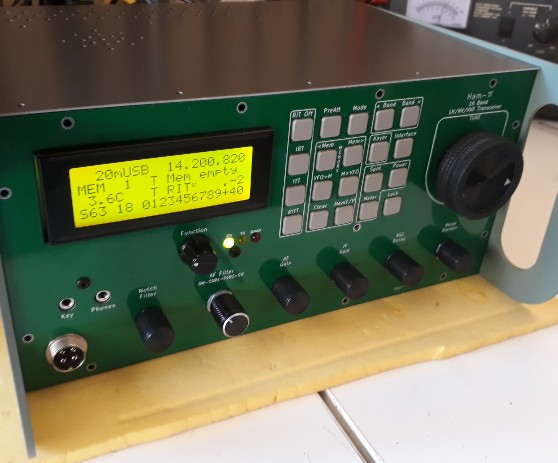
The HamPi16 is a 16 band LF/HF/VHF Amateur Radio project, for the home constructor. In the initial project the receiver can receive on the 1800 & 630 meter LF, all HF bands and the 8, 6, 4 & 2 meter VHF bands. On Transmit it works on all HF, 8, 6 & 4mtr VHF Bands.
- Very loosely based on the original OMEGA, this one has little wiring, a simple partitioned case, and is much easier to build.
- Very low noise receiver.
- 100watts output 160 through 10mtrs. Rather less on 8, 6 & 4 meter bands. QRP is possible of course by reducing the power. For an exclusive QRP rig (that has not been explored) it would mean some re-design by removing the PA finals amplifier stage. 10 – 15W would be possible. This should save money. (The two finals are RF70HVF1 devices).
- Ease of use built UI: One function per button keypad for fast and easy operation (No multi-depth menus!).
- Lots of real knobs! Noise blanker for wood-pecker etc, IF Gain & AGC Decay, AF Gain & AF Filter & Notch filter.
- SSB & Full break-in CW, both straight key and paddle (dual contact) keyer.
- Really low noise high performance receiver. (You can put the volume fully up and won’t be deafened by noise. You won’t loose weaker stations in the noise generated inside your rig. Try your rig. Pop on your headphones and turn up the volume on a free frequency…)
- Up to 16 bands. You just fit the parts for the bands you want
- Capable of 16 bands, but initially will be 1.8-54MHZ. The VFO is capable of all LF, HF & VHF bands
- LF and VHF bands (2m) following, VFO and BPF ready now
- Build on 4 PCBs with little inter-board wiring (Mainly ribbon cables)
- An extra data PCB built in provides a USB hub and connection to the processor for CAT, and inbuilt sound card for audio RX and TX connection.
- Function rotary control for adjustment of the function selected by the last button press
- 400 pulse per revolution tuning control, with a a spin and feel in a class of it’s own
- One Raspberry Pi Pico microprocessors and TFT digital readout.
- A lot of effort has gone into not compromising the original performance by including digital technology
- Various component footprints are designed for more than one component type to be used. Examples are for the relays, transistors/FETS, SSB filter etc.
- Any extra PCB space has been filled with PTH holes so experiments / enhancements can be fitted on-board. Many component footprints are combined so for instance wired or SMD transistors / FETs can be fitted (eg 3sk51 / BF998)
- Dual memory system built into the software functionality. One for more permanent frequency memories (Memory over power down), and the other for temporary memories say on contest days for fast memory store and delete for working through the band, and quick return to stations not yet worked
- IF Output for external waterfall displays etc.
![]()